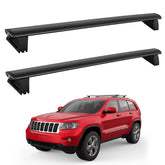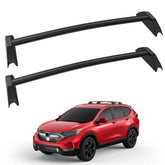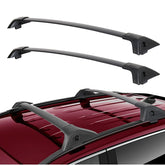Why do roof racks make noise and how to stop it?
Most car owners install roof racks on their cars to load more luggage, from compact city cars to SUVs, pickup trucks, and vans. This greatly improves the storage space of the vehicle and facilitates the transportation of various items, such as bicycles, suitcases, and kayaks.
Have you ever had this experience after installing a roof rack? You load all your gear into the car and prepare to move or go out. During the driving process, you hear a strange sound coming from the car's roof. It may be a soft rumble or a loud whistle. This noise is irritating and even prevents you from enjoying the music in the car.
This article will discuss why roof racks make noises and how we can stop or eliminate this noise. It only takes five minutes to make your driving more pleasant.

Why roof racks make noise?
There are many reasons why a roof rack makes noise, but the main reason is the airflow. Here are some common reasons why a roof rack makes noise:
- Air resistance: Wind blows onto the roof rack, which is an additional part of the vehicle and does not have the same aerodynamic characteristics as the rest of the vehicle. When the vehicle moves, air flows over and around the roof rack. This causes turbulence, which causes wind noise.
- Improper installation: If the roof rack is not firmly fixed or has loose parts, it will vibrate with the roof or itself, causing noise. Or when your wheels drive over uneven roads, they will squeak due to shaking or vibration. If it is installed correctly, it will not make this sound.
- Driving speed: If it is installed correctly, the roof rack will not make noise if you are not driving fast. But if you drive too fast, the roof rack will still make noise due to wind resistance. This is similar to the noise made by your vehicle moving fast on the highway, but we are not used to the noise made by the roof rack.
- Load shifting: If you load items on your roof rack if your cargo is not properly secured, it can cause it to vibrate and make noise while driving. In addition, loose cargo can damage your rack or even fall off the car, which is very dangerous to other people or vehicles on the road.
- Wind resistance: The shape and design of the roof rack affect how air flows around it. Gaps or open channels in the rack design or mounting method can allow air to pass through and cause noise.
- How the car roof is constructed: Some roofs are constructed in a way that creates a low-pressure area between them and the rack. At this time, the low-pressure area will "draw" the roof to the rack, and then quickly rebound. After multiple cycles, you will hear the vibration sound.

How can I stop roof rack noise?
The noise generated by a vehicle is always annoying and unpleasant. It is not difficult to solve the problem of noisy roof racks. You just need to make the roof rack more aerodynamic, which can greatly reduce or stop the noise. Here are a few ways to solve the noise problem, which you can do with DIY.
Use aerodynamic crossbars or install air deflectors on the front of the roof rack. These two methods are similar. They improve and simplify the roof rack, allowing the colliding air to easily bypass the roof rack and the transported items, immediately reducing or eliminating the noise. With this method, the driver can enjoy a quieter driving experience.
Install the roof rack correctly. Most roof rack manufacturers are working hard to solve the noise problem. If you can follow the installation instructions, most roof racks are quiet in themselves. Some installation steps are designed to eliminate noise, and our car owners can easily skip these steps. This leads to the inevitable noise of the roof rack.
Ensure a secure installation. It is crucial to check the installation of the roof rack regularly. Improper installation or loose parts may cause additional noise during driving. It is recommended to regularly check the bolts, clamps, and all connections to ensure that they are tight and not damaged. Timely adjustments and maintenance can significantly reduce noise and improve the safety of the roof rack.
Optimize the load. It is important to choose the right items and packages when placing the load on the roof rack. Try to avoid using irregularly shaped or oversized objects, which may cause instability in the airflow during driving, thereby increasing wind noise. It is recommended to use specially designed suitcases or bags to ensure that they are placed smoothly and compactly on the roof rack to optimize airflow and reduce noise.
Use wind protection accessories. Roof rack manufacturers usually provide wind protection accessories such as wind deflectors, windshields or wind resistance plates, which can effectively reduce the noise generated by wind flow. By installing these accessories on the roof rack, the path of the airflow can be changed, and the direct contact between the wind and the roof rack can be reduced, thereby reducing wind noise.

Conclusion
All in all, it is not difficult to solve the problem of roof rack noise. The main reasons for the noise generated by roof racks during driving include aerodynamic factors, loose accessories, and friction at the contact points with the vehicle. These noises may not only affect the driving experience but may also cause other potential problems, such as wear and damage to accessories. By taking effective measures promptly, car owners can not only improve driving comfort but also extend the service life and performance of the roof rack. Maintaining regular maintenance and inspections is the key to ensuring the efficient operation of the roof rack. Only in this way can you enjoy the fun and convenience of driving and reduce the discomfort caused
Featured Products
- $83.99
- $83.99
- Unit price
- / per
- $85.99
$138.90- $85.99
- Unit price
- / per
- $69.99
- $69.99
- Unit price
- / per
- $98.99
- $98.99
- Unit price
- / per














